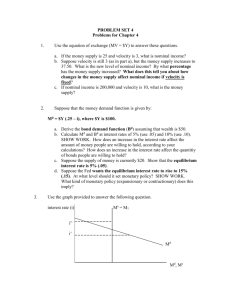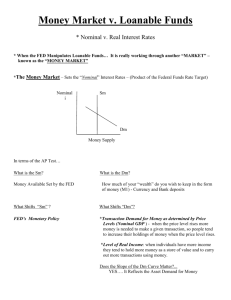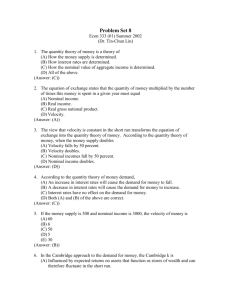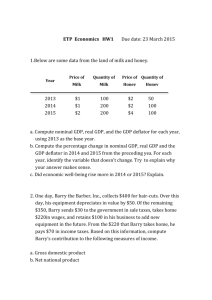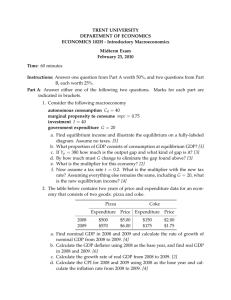REVIEW QUESTIONS MONEY GROWTH AND INFLATION
advertisement
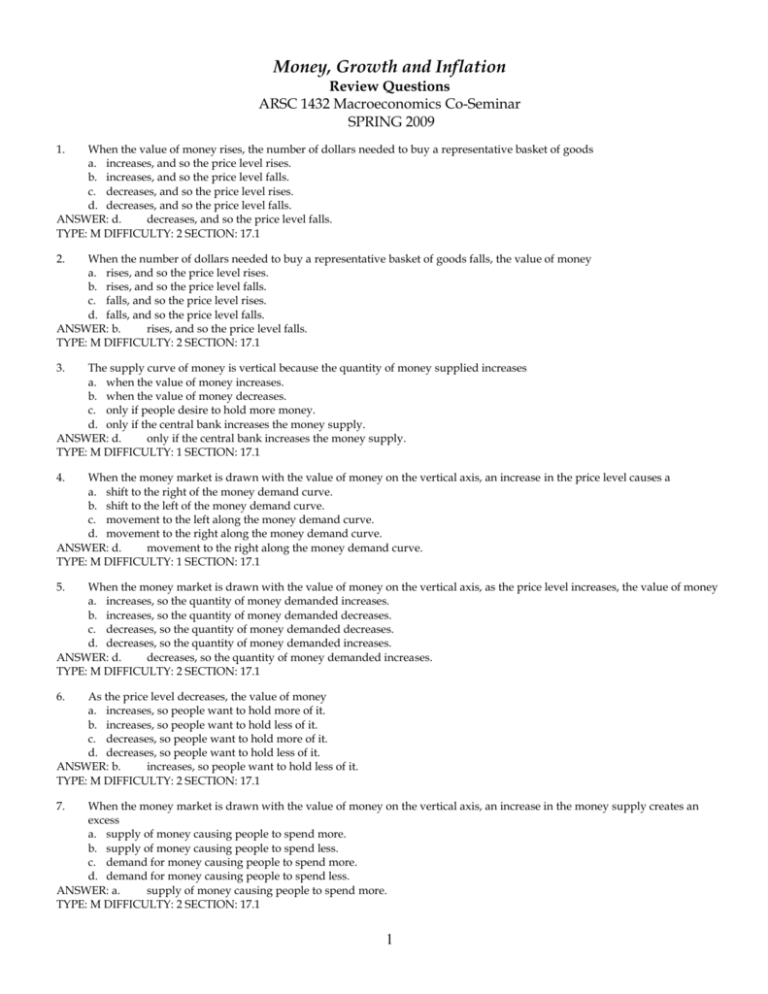
Money, Growth and Inflation Review Questions ARSC 1432 Macroeconomics Co-Seminar SPRING 2009 1. When the value of money rises, the number of dollars needed to buy a representative basket of goods a. increases, and so the price level rises. b. increases, and so the price level falls. c. decreases, and so the price level rises. d. decreases, and so the price level falls. ANSWER: d. decreases, and so the price level falls. TYPE: M DIFFICULTY: 2 SECTION: 17.1 2. When the number of dollars needed to buy a representative basket of goods falls, the value of money a. rises, and so the price level rises. b. rises, and so the price level falls. c. falls, and so the price level rises. d. falls, and so the price level falls. ANSWER: b. rises, and so the price level falls. TYPE: M DIFFICULTY: 2 SECTION: 17.1 3. The supply curve of money is vertical because the quantity of money supplied increases a. when the value of money increases. b. when the value of money decreases. c. only if people desire to hold more money. d. only if the central bank increases the money supply. ANSWER: d. only if the central bank increases the money supply. TYPE: M DIFFICULTY: 1 SECTION: 17.1 4. When the money market is drawn with the value of money on the vertical axis, an increase in the price level causes a a. shift to the right of the money demand curve. b. shift to the left of the money demand curve. c. movement to the left along the money demand curve. d. movement to the right along the money demand curve. ANSWER: d. movement to the right along the money demand curve. TYPE: M DIFFICULTY: 1 SECTION: 17.1 5. When the money market is drawn with the value of money on the vertical axis, as the price level increases, the value of money a. increases, so the quantity of money demanded increases. b. increases, so the quantity of money demanded decreases. c. decreases, so the quantity of money demanded decreases. d. decreases, so the quantity of money demanded increases. ANSWER: d. decreases, so the quantity of money demanded increases. TYPE: M DIFFICULTY: 2 SECTION: 17.1 6. As the price level decreases, the value of money a. increases, so people want to hold more of it. b. increases, so people want to hold less of it. c. decreases, so people want to hold more of it. d. decreases, so people want to hold less of it. ANSWER: b. increases, so people want to hold less of it. TYPE: M DIFFICULTY: 2 SECTION: 17.1 7. When the money market is drawn with the value of money on the vertical axis, an increase in the money supply creates an excess a. supply of money causing people to spend more. b. supply of money causing people to spend less. c. demand for money causing people to spend more. d. demand for money causing people to spend less. ANSWER: a. supply of money causing people to spend more. TYPE: M DIFFICULTY: 2 SECTION: 17.1 1 8. A decrease in the money supply creates an excess a. supply of money that is eliminated by rising prices. b. supply of money that is eliminated by falling prices. c. demand for money that is eliminated by rising prices. d. demand for money that is eliminated by falling prices. ANSWER: d. demand for money that is eliminated by falling prices. TYPE: M DIFFICULTY: 2 SECTION: 17.1 9. When the money market is drawn with the value of money on the vertical axis, long-run equilibrium is obtained when the quantity demanded and quantity supplied of money are equal due to adjustments in the a. the value of money. b. real interest rates. c. nominal interest rates. d. money supply. ANSWER: a. the value of money. TYPE: M DIFFICULTY: 2 SECTION: 17.1 10. When the money market is drawn with the value of money on the vertical axis, if the price level is above the equilibrium level, there is a a. shortage, so the price level will rise. b. shortage, so the price level will fall. c. surplus, so the price level will rise. d. surplus, so the price level will fall. ANSWER: b. shortage, so the price level will fall. TYPE: M DIFFICULTY: 3 SECTION: 17.1 11. When the money market is drawn with the value of money on the vertical axis, which of the following would shift money demand right? a. an increase in the price level b. a decrease in the price level c. open-market purchases by the central bank d. None of the above is correct. ANSWER: d. None of the above is correct. TYPE: M DIFFICULTY: 2 SECTION: 17.1 Use the figure below for the following questions. 12. If the money supply is MS2 and the value of money is 2, a. the value of money is less than its equilibrium level. b. the price level is higher than its equilibrium level. c. money demand is greater than the money supply. d. the money supply is greater than money demand. ANSWER: d. the money supply is greater than money demand. TYPE: M DIFFICULTY: 2 SECTION: 17.1 2 13. If the money supply is MS2 and the value of money is 2, there is excess a. demand equal to the distance between A and C. b. demand equal to the distance between A and B. c. supply equal to the distance between A and C. d. supply equal to the distance between A and B. ANSWER: d. supply equal to the distance between A and B. TYPE: M DIFFICULTY: 2 SECTION: 17.1 14. When the money supply curve shifts from MS1 to MS2, a. the demand for goods and services decreases. b. the economy's ability to produce goods and services increases. c. the equilibrium price level increases. d. the equilibrium value of money increases. ANSWER: c. the equilibrium price level increases. TYPE: M DIFFICULTY: 1 SECTION: 17.1 15. When the money supply curve shifts from MS1 to MS2, a. the equilibrium value of money decreases. b. the equilibrium price level decreases. c. the supply of money has decreased. d. the demand for goods and services will decrease. ANSWER: a. the equilibrium value of money decreases. TYPE: M DIFFICULTY: 1 SECTION: 17.1 16. If the current money supply is located at MS1, a. there is no excess supply or excess demand if the value of money is 2. b. the equilibrium is at point C. c. there is an excess supply of money if the value of money is 1. d. All of the above are correct. ANSWER: a. there is no excess supply or excess demand if the value of money is 2. TYPE: M DIFFICULTY: 1 SECTION: 17.1 17. According to the classical dichotomy, when the money supply doubles, which of the following also double? a. the price level and nominal wages b. the price level, but not the nominal wage c. the nominal wage, but not the price level d. neither the nominal wage nor the price level ANSWER: a. the price level and nominal wages TYPE: M DIFFICULTY: 1 SECTION: 17.1 18. According to the principle of monetary neutrality, a decrease in the money supply will not change a. nominal GDP. b. the price level. c. unemployment. d. All of the above are correct. ANSWER: c. unemployment. TYPE: M DIFFICULTY: 1 SECTION: 17.1 19. Last year Tealandia produced 50,000 bags of green tea, which sold at 4 units each of Tealandia’s currency—the Leaf. Tealandia’s money supply was 10,000. What was the velocity of money in Tealandia? a. 20 b. 5 c. 1/20 d. 1/5 ANSWER: a. 20 TYPE: M DIFFICULTY: 1 SECTION: 17.1 3 20. The money supply in Freedonia is $200 billion. Nominal GDP is $800 billion and real GDP is $400 billion. Assuming that velocity is stable, if real GDP grows by 10 percent this year, and if the money supply does not change this year, then a. the inflation rate will be zero. b. nominal GDP will grow by 10 percent. c. nominal GDP will stay the same. d. none of the above are correct. ANSWER: c. nominal GDP will stay the same. TYPE: M DIFFICULTY: 3 SECTION: 17.1 21. The money supply in Freedonia is $200 billion. Nominal GDP is $800 billion and real GDP is $400 billion. Assuming that velocity is stable, if real GDP grows by 10 percent this year, and if the money supply does not change this year, then the a. inflation rate will be zero. b. price level will fall by 9.09 percent. c. price level will rise by 10 percent. d. None of the above is correct. ANSWER: b. price level will fall by 9.09 percent. TYPE: M DIFFICULTY: 3 SECTION: 17.1 22. Velocity in the country of Nemedia is always stable. In 2001, the money supply was $100 billion and real GDP was $300 billion. In 2002, the money supply increased by 10 percent, real GDP increased by 5 percent and nominal GDP equaled $660 billion. By how much did the price level increase between 2001 and 2002? a. 10 percent b. 9.5 percent c. 4.76 percent d. There is not enough information to answer the question. ANSWER: c. 4.76 percent TYPE: M DIFFICULTY: 3 SECTION: 17.1 23. Velocity in the country of Aquilonia is always stable. In 2002, the money supply was $100 billion, nominal GDP was $500 billion, and the real interest rate was 3 percent. In 2003, the money supply was $105 billion and real GDP did not change from its level in 2002. The nominal interest rate in 2003 was approximately a. 3 percent. b. 5 percent. c. 8 percent. d. 11 percent. ANSWER: c. 8 percent. TYPE: M DIFFICULTY: 3 SECTION: 17.1 24. Which of the following is not implied by the quantity equation? a. If velocity is stable, an increase in the money supply creates a proportional increase in nominal output. b. If velocity is stable and money is neutral, an increase in the money supply creates a proportional increase in the price level. c. With constant money supply and output, an increase in velocity creates an increase in the price level. d. With constant money supply and velocity, an increase in output creates a proportional increase in the price level. ANSWER: d. With constant money supply and velocity, an increase in output creates a proportional increase in the price level. TYPE: M DIFFICULTY: 3 SECTION: 17.1 25. The nominal interest rate is 3 percent and the inflation rate is 2 percent. What is the real interest rate? a. 6 percent. b. 5 percent. c. 1 percent. d. 3/2 percent. ANSWER: c. 1 percent. TYPE: M DIFFICULTY: 1 SECTION: 17.1 26. Arnold puts money into an account. One year later he checks and sees that he has 5 percent more dollars and that his money will buy 6 percent more goods. a. The nominal interest rate was 11 percent and the inflation rate was 5 percent. b. The nominal interest rate was 6 percent and the inflation rate was 5 percent. c. The nominal interest rate was 5 percent and the inflation rate was –1 percent. d. None of the above is correct. ANSWER: c. The nominal interest rate was 5 percent and the inflation rate was –1 percent. TYPE: M DIFFICULTY: 2 SECTION: 17.1 4

